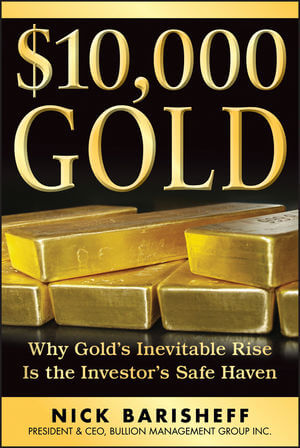$10,000 gold?
Time will tell if Nick Barisheff's new book, $10,000 Gold, belongs in the same category as such overly bullish stock-market books as Dow 36,000 or Dow 100,000 or whether Barisheff will ultimately get the last laugh.
Advertisement
Time will tell if Nick Barisheff's new book, $10,000 Gold, belongs in the same category as such overly bullish stock-market books as Dow 36,000 or Dow 100,000 or whether Barisheff will ultimately get the last laugh.
 Given the recent shellacking in the price of gold, you have to sympathize with the unfortunate timing of the publication of a book entitled $10,000 Gold. Given the long lead times involved in book publishing, I’m sure the publishers were powerless to do anything about it; on the other hand, the “any publicity is good publicity” school of thought might even view the recent massive publicity over gold’s alleged demise as ultimately a positive.
I would normally view a book with such a title with considerable skepticism even though, as the previous blog post reveals, I’ve long been a believer in having a 5 to 10% position in some combination of gold or precious metals stocks, mutual funds or ETFs, or the underlying physical metals (coins or bullion bars).
Given the recent shellacking in the price of gold, you have to sympathize with the unfortunate timing of the publication of a book entitled $10,000 Gold. Given the long lead times involved in book publishing, I’m sure the publishers were powerless to do anything about it; on the other hand, the “any publicity is good publicity” school of thought might even view the recent massive publicity over gold’s alleged demise as ultimately a positive.
I would normally view a book with such a title with considerable skepticism even though, as the previous blog post reveals, I’ve long been a believer in having a 5 to 10% position in some combination of gold or precious metals stocks, mutual funds or ETFs, or the underlying physical metals (coins or bullion bars).
 The second is that I’d also watched the development of this manuscript over the years and note with interest that it has finally been published by perhaps the most credible North American publisher out there in the field of financial non-fiction: Wiley (in this case, John Wiley & Sons Canada). Furthermore, Wiley has chosen to publish this as a hard-cover edition at a suggested retail price of $39.95. That’s at the upper end of the range for such books and I note the irony that such a price is slightly over the $35 price of an ounce of gold that held throughout a large part of the early 20th century.
There’s little doubt that Barisheff has immersed himself in at least a decade’s worth of research on this subject, which is one reason that slowly but surely he has become a go-to source for journalists writing on the topic of gold and precious metals. Of course, journalists normally seek out at least two sources on any topic, generally to provide a balanced perspective that includes insights from two different camps.
A counterview might have strengthened the manuscript
If there is a weakness in $10,000 Gold, it is this: anyone viewing this industry with some objectivity would be forced to put Barisheff himself in the “gold bug” camp, however much he or Wiley might disclaim such a characterization. The book’s subtitle is “Why Gold’s Inevitable Rise is the Investor’s Safe Haven,” but you’d expect such a conclusion from someone whose day job is providing gold and precious metals in various types of investments, wouldn’t you?
The manuscript could have benefited from a co-author less aligned with the industry, or at least an extensive foreword from an outsider. Similarly, too many of the back-cover blurbs come from sources close to the precious metals industry, such as David Morgan (founder of Silver-Investor.com).
That all said, anyone looking for a one-stop investment guide to all things gold can hardly ignore this book. Students of paper (aka “fiat”) money, central banks, inflation and hyperinflation will find plenty of grist for their mill here. Even investors who have a small amount of gold exposure as “insurance” may find Barisheff’s cautions against ETFs like GLD or SLV of interest. These two ETFs in particular are arguably one reason gold investing became so popular over the decade-long bull market the precious metal has enjoyed. Both appeal to people who prefer owning bullion to mining stocks that are really just paper claims on precious metals. Barisheff, however, seems to view precious metals ownership via such electronic vehicles as one or two steps removed from the real thing, making them suspect if things came to such a pass that investors really wanted to collect on the insurance they thought they’d purchased.
For now, I’ll put my review copy of the book in my extensive financial library, for handy reference. Time will tell if $10,000 Gold belongs in the same category as such overly bullish stock-market books as Dow 36,000 or Dow 100,000, or whether Barisheff will ultimately get the last laugh.
Gold & Financial Independence
P.S. For more on this theme, see “Gold and Findependence” here.
The second is that I’d also watched the development of this manuscript over the years and note with interest that it has finally been published by perhaps the most credible North American publisher out there in the field of financial non-fiction: Wiley (in this case, John Wiley & Sons Canada). Furthermore, Wiley has chosen to publish this as a hard-cover edition at a suggested retail price of $39.95. That’s at the upper end of the range for such books and I note the irony that such a price is slightly over the $35 price of an ounce of gold that held throughout a large part of the early 20th century.
There’s little doubt that Barisheff has immersed himself in at least a decade’s worth of research on this subject, which is one reason that slowly but surely he has become a go-to source for journalists writing on the topic of gold and precious metals. Of course, journalists normally seek out at least two sources on any topic, generally to provide a balanced perspective that includes insights from two different camps.
A counterview might have strengthened the manuscript
If there is a weakness in $10,000 Gold, it is this: anyone viewing this industry with some objectivity would be forced to put Barisheff himself in the “gold bug” camp, however much he or Wiley might disclaim such a characterization. The book’s subtitle is “Why Gold’s Inevitable Rise is the Investor’s Safe Haven,” but you’d expect such a conclusion from someone whose day job is providing gold and precious metals in various types of investments, wouldn’t you?
The manuscript could have benefited from a co-author less aligned with the industry, or at least an extensive foreword from an outsider. Similarly, too many of the back-cover blurbs come from sources close to the precious metals industry, such as David Morgan (founder of Silver-Investor.com).
That all said, anyone looking for a one-stop investment guide to all things gold can hardly ignore this book. Students of paper (aka “fiat”) money, central banks, inflation and hyperinflation will find plenty of grist for their mill here. Even investors who have a small amount of gold exposure as “insurance” may find Barisheff’s cautions against ETFs like GLD or SLV of interest. These two ETFs in particular are arguably one reason gold investing became so popular over the decade-long bull market the precious metal has enjoyed. Both appeal to people who prefer owning bullion to mining stocks that are really just paper claims on precious metals. Barisheff, however, seems to view precious metals ownership via such electronic vehicles as one or two steps removed from the real thing, making them suspect if things came to such a pass that investors really wanted to collect on the insurance they thought they’d purchased.
For now, I’ll put my review copy of the book in my extensive financial library, for handy reference. Time will tell if $10,000 Gold belongs in the same category as such overly bullish stock-market books as Dow 36,000 or Dow 100,000, or whether Barisheff will ultimately get the last laugh.
Gold & Financial Independence
P.S. For more on this theme, see “Gold and Findependence” here.
Share this article Share on Facebook Share on Twitter Share on Linkedin Share on Reddit Share on Email